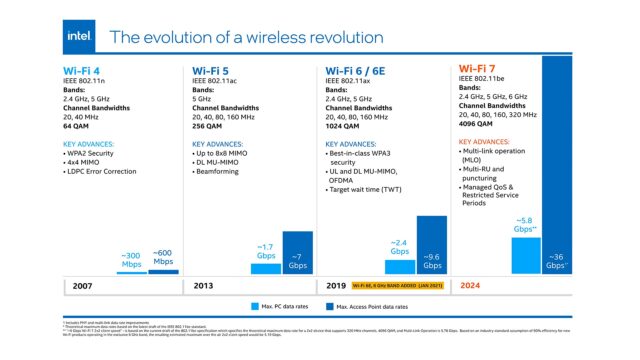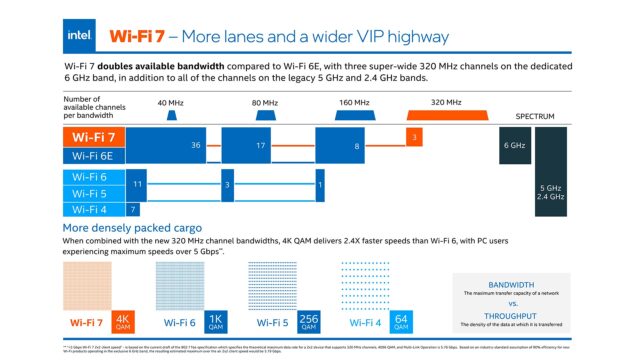
Intel to Unveil Wi-Fi 7 in 2024, Will Double the Speed of Wi-Fi 6E
Intel is hard at work on the next generation of Wi-Fi standards, according to a from Korea IT News. Wi-Fi 7 will replace the current Wi-Fi 6/6E as the latest standard when it debuts in 2024. It theoretically allows for data transfer rates that are more than twice as fast as those with Wi-Fi 6E. Intel says it plans on submitting its plans to the Wi-Fi Alliance in order to gain certification. Once that occurs, it will offer it in mobile products first, with desktops to follow. If all goes according to plan, it should be hitting major markets by 2025.
‘s actual name is 802.11be. The new standard will boost data transfer rates from ~2.4Gb/s to ~5.8Gb/s according to Intel. The maximum transfer rate for the access point will skyrocket from ~9.6Gb/s to ~36Gb/s as well. Naturally, these are all rough numbers, and various factors are involved in determining wireless network speeds. Still, it represents a notable leap forward compared with Wi-Fi 6E. Intel says it’s designed on the foundation of Wi-Fi 6E, but offers improved performance, lower latency, and more reliability. Like Wi-Fi 6E it allows for operation in the 6GHz band. However, it introduces three ultra-wide channels at 320MHz, which are twice as wide as before. This allows for more data to be included in each transmission.

(Image: Intel)
Another feature that helps increase bandwidth is 4K Quadrature Amplitude Modulation (QAM). This is a big upgrade over 1024-QAM (1K QAM) found in Wi-Fi 6. The much-older Wi-Fi 5 standard only offered 256-QAM. It allows for higher peak data transfer rates and a more reliable signal.

(Image: Intel)
Multi-Link Operation (MLO) is also a key feature of Wi-Fi 7, and it allows for a simultaneous connection to two frequency bands at once. It will let people connect to both the 5GHz and 6GHz band. The access point can then intelligently switch bands according to traffic, or use both bands at the same time. Typically uncontested bands deliver maximum performance. This is why 5GHz is usually better for performance than the congested 2.4GHz frequency (design differences aside). With Wi-Fi 7, you will be able to use both uncongested frequency bands at once, which should allow for noticeable performance improvements.
According to Korea IT News, even though the technology is years away, Intel thinks it can make it even faster. “Wi-Fi 7 almost doubles the frequency bandwidth of 802.11ax (170 MHz) to 320MHz and doubles the speed of Wi-Fi,” said Eric McLaughlin, VP of Intel’s wireless division. “Since there is more than a year left before the release of 802.11be, there is still a chance that we could improve the processing speed even further.”
It’s notable Intel is working on the next standard for Wi-Fi when many companies still haven’t officially adopted Wi-Fi 6E yet. As points out, Apple has yet to switch, despite its reputation for offering next-gen hardware before other companies. It did so most notably with USB Type-C, way back in 2015. It’s expected to roll it out with its upcoming iPhone 14, however.
Now Read: